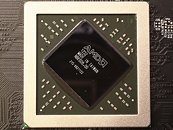Friday, April 12th 2019

AMD Wins Back Three Graphics Patents from LG
AMD won back ownership of three graphics patents that had earlier been struck down on a complaint by LG Electronics. A U.S. Court of Appeals for the Federal Circuit overruled a ruling of the Patent Trial and Appeal Board (PTAB) which observed that AMD subsidiary ATI Technologies ULC (now reorganized as RTG), has a claim to U.S. patents numbered 7,742,053, 6,897,871, and 7,327,369. The three patents deal with critical technology related to Unified Shaders.
The PTAB had earlier dismissed ATI's ownership of the patents on grounds that the IP claimed was "too obvious in light of prior art." A bench of three Judges in a unanimous decision ruled that ATI had "had conceived of their inventions before the prior art." Put simply, the court was satisfied that the technologies protected by these patents were invented by ATI before the "prior art," and were not "obvious next steps" to it.
Source:
IP Watchdog
The PTAB had earlier dismissed ATI's ownership of the patents on grounds that the IP claimed was "too obvious in light of prior art." A bench of three Judges in a unanimous decision ruled that ATI had "had conceived of their inventions before the prior art." Put simply, the court was satisfied that the technologies protected by these patents were invented by ATI before the "prior art," and were not "obvious next steps" to it.

27 Comments on AMD Wins Back Three Graphics Patents from LG
A fish rots from the head down.
Unified shaders are D3D10/SM4. Unified shaders is a strange thing to have a patent on - AMD did Xenos and Terascale, Nvidia had Tesla around the same time and if my memory serves right Intel, PowerVR, S3 as well as Adreno/Mali use unified shaders. Some or most of these were developed at around the same time.
I guess LG appealed in PTAB and they ruled in their favor, while Federal Court came to the opposite conclusion.
The only few things I don't understand is:
1) [puts on this 2018 hat] I thought LG already settled with AMD
2) [puts on his 2017 hat] Why go after all of these companies, if the perpetrator is ARM holdings, who licensed graphics IP to all others.
AMD Files Patent Infringement Complaint Against LG, MediaTek, Sigma Designs, and Vizio (Anandtech)
www.sigmadesigns.com/
www.itcblog.com/images/amdcomplaint.pdf
LG countersued saying they should be public domain, LG won. AMD appealed and the appellate court ruled the original complaint and patents are valid.TL;DR: AMD owns the "unified shader" concept. LG, Vizio, MediaTek, and SDI failed to pay license to it.Samsung was named in the complaint as paying license fees.
I just realized that LG counter-sued alleging older patents are void rather than the four named above:
7,742,053 Multi-thread graphics processing system
6,897,871 Graphics processing architecture employing a unified shader - this dates back to 2003. The '967 application is clearly a renewal of this one.
7,327,369 Graphics processing architecture employing a unified shader - also dates back to 2003. Despite being titled the same, they are not.
All I can say is Good, maybe a new arch will finally come out.
You have to ask yourself why would the PATB try and vacate AMD's Patents? In my opinion they were approached by Intel.
Why did INtel poach so many AMD Radeon executives? WIth AMD IP removed from AMD Intel and Raja Khoduri would be able to copy Radeon GPU's.
This decision ends Intel's GPU prospect rather effectively. At least that is my opinion anyway.
LG displays are not as good as Samsung's. My LG crapped out basically. It would randomly go blank (normal power light still on not standby light) for a couple secs and it progressively got to be like randomly go off for 5-10 minutes. I babied the thing as well and took good care of it. My samsung has been thru a lot more and still ticking. My new 2ndary is a dell E2013H is really nice and it was only 40USD (or My LG phone I had (G3 I think) barely lasted a month (battery was defective and display had some bleeding and touch was terrible). Gave it to mom to use for a trip to Poland or somethin to use for recording videos as a backup. She can keep the thing lol. Samsung phone was much better. My Nexus 6 is pretty good.